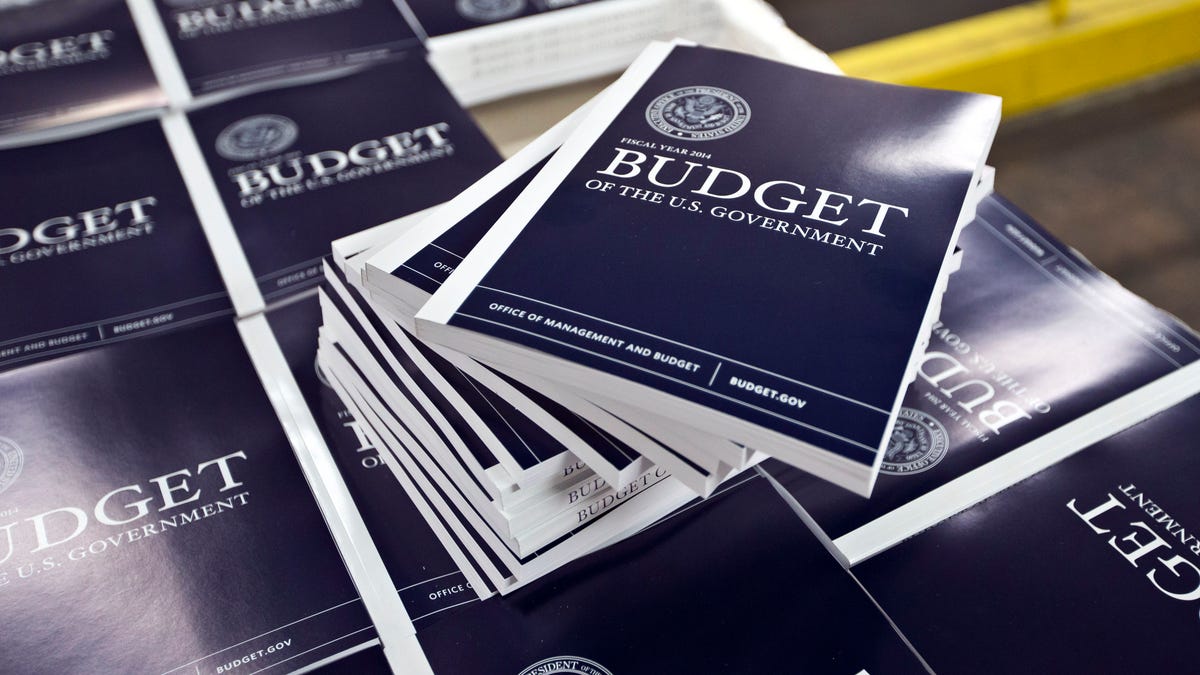
April 8, 2013: Copies of President Obama's budget plan for fiscal year 2014 are prepared for delivery at the U.S. Government Printing Office in Washington.
At last, the paper-pushing federal government is starting to join banks and utilities and countless other industries in moving its operations online.
But not so fast. A paper industry-backed group recently has launched a pricey public relations campaign in a bid to slow the federal government's dive into the digital age, by lobbying to bring back paper printing. The group, Consumers for Paper Options, is courting Congress to make sure the industry doesn’t get shredded.
John Runyan, the group’s executive director, says it’s not about trying to digitally dumb down the government but instead to provide a choice to those who don’t have easy access to computers. Runyan argues that seniors as well as those living in low-income or rural areas that don’t have easy access to computers or the Internet are among the hardest hit.
“Are we trying to turn back the clock and get everyone off the Internet? Absolutely not,” Runyan told FoxNews.com. “What we’re saying is that the government cannot race ahead of the public’s ability to get online.”
Still, paper copies come at a cost to taxpayers. And so far, his lobbying group has had some success in winning over Washington.
They were able to slide language into last month’s budget deal that forces the government to resume paper delivery of annual Social Security earnings statements to 150 million Americans.
The 2011 decision by the Social Security Administration to stop mailing paper earnings statements saved the country an estimated $72 million a year, according to government estimates.
Last year, Runyan’s group, which receives financial backing from the paper industry’s largest trade group as well as the Envelope Manufacturers Association, was able to lift language from a bill that would have ended the practice of printing pharmaceutical prescription information and labels into drug packages.
Big drug companies had been pushing to digitize the inserts as a way to cut down on costs for years with varied success.
Despite Runyan’s successes, the case to keep paper printing has been a tough sell, especially during lean economic times.
According to the General Services Administration, in 2013, 22 of the largest federal agencies reduced their reliance on paper by 7 percent, saving taxpayers $64 million a year.
Last year, the Treasury Department suspended most of its paper mailing – a move estimated to save taxpayers $1 billion over the next decade.
Nationally, there have been deep cuts in the paper and pulp industries. In 2000, 96 million tons of paper were produced compared with 82 million tons produced in 2012. Four decades ago, there were 800 mills operating across the country. Today, there are only 350.
Linda Sherry, director of national priorities at Consumer Action, told FoxNews.com her organization is signing on to the pro-paper fight.
“Bottom line, we don’t want to stop electronic commerce,” she told FoxNews.com. “As a taxpayer, I like savings. But my sense is that the vast majority of people will choose the paperless option, but there is a small fraction of people who don’t have access.”
Sherry, who believes it will take another 20 years before everyone in America becomes a "digital citizen," says access and security cause the most hesitancy about using an online government portal.
“Password management alone is very difficult,” Sherry said. “I also find that for the regular people – consumers – it can be a real pain in the neck. If you don’t have a computer, they say to go to a library. Have you seen the lines at the library? Every computer is taken and there is a waiting list.”
Runyan says people will continue to be hesitant about filing everything from IRS claims to paying college loans online. “We’re pushing people online but the government has failed to provide basic security systems,” he said. “There are people stealing identities and filing false returns.”
Congress, as with many things, is divided on the issue of paper. While some House Republicans have pushed legislation to stop printing excess copies of bills, for instance, other lawmakers have been sympathetic to the paper business.
Runyan met with Rep. Susan Davis, D-Calif., and was able to get her to put the language in the budget bill forcing the Social Security Administration to come up with a way -- and the money -- to restore mailing millions of Social Security statements.
Last year, Rep. Michael Michaud, D-Maine, helped the group's agenda when he argued that eliminating paper would be problematic for rural states like his.
In a Dec. 5, 2013 column in the Wausau Daily Herald, Rep. Sean Duffy, R-Wisc., said the rush to go paperless is leaving too many people behind.
"Seniors make up the lion's share of those who are being left behind while the rest of America goes online," he wrote. "More than half of Americans older than 65 are without Internet, while nearly half lack basic computer access."
According to the National Conference of State Legislatures, several states have been at least experimenting with putting government business online not only to save money but, they say, to increase public access to material.
Last month, New York lawmakers approved a bill to go paperless -- a move estimated to save the state $13 million a year. It was a hard-fought victory for the bill's sponsor, Assemblyman James Tedisco, who's been pushing for the government to go digital for years.
"It's common sense," Tedisco told reporters about his fight following the vote.
The "Digital Government Strategy" backed by the White House also moves away from traditional paper printing in favor of a more digital platform. A bill sponsored by Reps. Gerry Connolly, D-Va., and Anna Eshoo, D-Calif., calls for the creation of a U.S. Digital Government Office, which would review and guide government tech projects to make sure all federal agencies are on the same page with one another.




